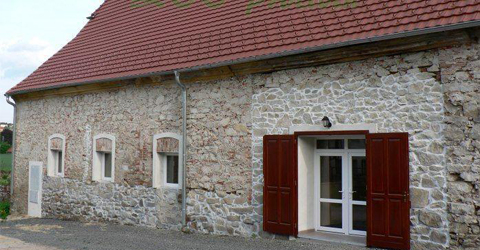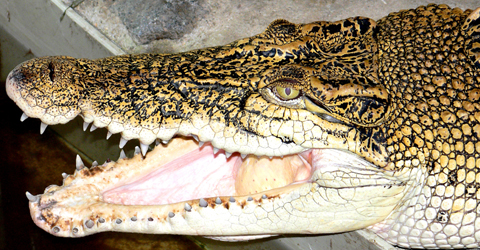History of ZOO
The Protivín Crocodile Zoo was established on the basis of the private breeding program of the zoo’s operator, Miroslav Procházka. He became interested in crocodiles at a young age at the Young Naturalists’ Station in Písek, where he acquired basic knowledge of crocodile breeding. He has been breeding them privately since 1996, but he began building a comprehensive collection of crocodile species in 2000. He has been successfully breeding crocodiles since 2005.
In the first half of the 20th century, as part of land reform, the property was transferred to a private owner who ran a carpentry workshop there, while other parts of the building were used as warehouses. The property was purchased from the direct descendants of this owner by the founder of the zoo in 2005.
The exhibition part of the zoo itself is being built in Protivín in a historic farm building dating back to the late 18th century. In the 19th century, it served as a stable for horses, a coach house, and a service apartment for coachmen, and belonged to the grounds of Protivín Castle, which was owned by the Schwarzenberg family.
The original breeding took place on his farm in Chvalšiny, and since 2005, an exhibition area has been under construction at the zoo in Protivín. The farm in Chvalšiny has been preserved and serves as a breeding and supply farm for the zoo. Miroslav Procházka applied for a zoo license from the Czech Ministry of the Environment in accordance with Act No. 162/2003 Coll. in January 2008, and the license was granted in May.

Project
The zoo was built in a strictly ecological style. Its sole purpose is not only to breed, reproduce, and exhibit crocodiles, but also to use and promote ecological technologies. That is why the first thing to be built in the zoo was an energy unit consisting of three heat pumps with a total thermal output of almost 100 kW. This value corresponds to the thermal resistance of the building, so it sufficiently supplies heat to almost 2,000 m² of floor space for crocodile enclosures. The heat pumps draw heat from eight 120 m deep boreholes that were drilled on land adjacent to the zoo. The entire construction of the zoo was divided into several stages.
The first stage ran from 2005 to early 2008 and involved the construction of the above-mentioned energy unit, i.e., a system of boreholes and heat pumps, administrative facilities, and the first eleven terrariums for medium-sized crocodiles. In June 2008, this first part of the zoo was opened to the public, with a total of 18 species of alligators, caimans, crocodiles, and gavials housed in the terrariums at that time.
Further stages of the zoo’s construction took place in the following period, with the most intensive changes occurring in 2011 and 2012, when the zoo’s reconstruction project was supported by the EU ROP-Southwest fund and large terrariums for breeding giant crocodile species were built. When these areas, referred to as the second and third stages, were opened on June 27, 2012, the zoo already kept twenty-two species of crocodiles, including a large group of Indian gavials. From a technical point of view, it is interesting that the largest terrarium – approx. 110 m² – is built on the first floor and, like all terrariums for large crocodile species, has a 1 m deep pool. Gharials are kept in this terrarium. The zoo has taken on a distinctly breeding character. In 2013, rare Philippine crocodiles began to reproduce at the zoo, and the zoo gradually became a member of rescue programs run by the EAZA (European Association of Zoos and Aquaria) for five critically endangered crocodile species.
The last, fourth stage of the zoo building’s reconstruction took place in 2015. It involved the reconstruction and modernization of the original part of the zoo, which had become somewhat outdated since 2008. This stage of the zoo’s construction was again supported financially by a grant from the EU ROP-Southwest fund.
With the opening of the modernized part of the zoo on June 30, 2015, the crocodile zoo took on its final form. Thanks to support from the EU ROP – Southwest fund, it has become a popular tourist destination while also fulfilling its conservation, breeding, and educational functions.
Breeding and exhibition plan
The exhibition aims to display all 25 recent crocodile species in their final form. This aim is complemented by the construction of a zoological museum, where osteological and, to a lesser extent, dermoplastic preparations of not only crocodiles but also other representatives of the animal kingdom are exhibited. In terms of breeding, emphasis is placed on establishing breeding groups of endangered and critically endangered crocodile species, not only in the exhibition itself, but also on the farm, so that these animals have optimal conditions for reproduction.

Currently, these groups have been created for six (Alligator sinensis, Crocodylus siamensis, Crocodylus rhombifer, Crocodylus mindorensis, Tomistoma schlegelii, and Gavialis gangeticus) of the seven endangered and critically endangered species, with four (C. rhombifer, C. siamensis, C. mindorensis, Gavialis gangeticus) are already breeding regularly. The Sunda gharials (syn. Tomistoma schlegelii) have already laid eggs during breeding at our zoo, but unfortunately, they were not successfully incubated. Perfecting the incubation technique for this rare species is a challenge for the zoo in the future.
The Protivín Crocodile Zoo has bred the following species of crocodiles: Cuban crocodile (C. rhombifer), Siamese crocodile (C. siamensis), Nile crocodile (C. niloticus), spectacled caiman (Caiman crocodilus), Philippine crocodile (C. mindorensis), Morelet’s crocodile (C. moreletii), Indian gharial (Gavialis gangeticus), and saltwater crocodile (Crocodylus porosus).
When endangered species are successfully bred, the question arises of how to deal with the offspring so that breeding is not just a fulfillment of the breeders’ wishes and ideals, but becomes a practical aid to species conservation. To this end, the zoo has become a member of European conservation programs, specifically the European Association of Zoos and Aquaria (EAZA) studbooks for five species of crocodiles, and the offspring find their next home within these programs.
